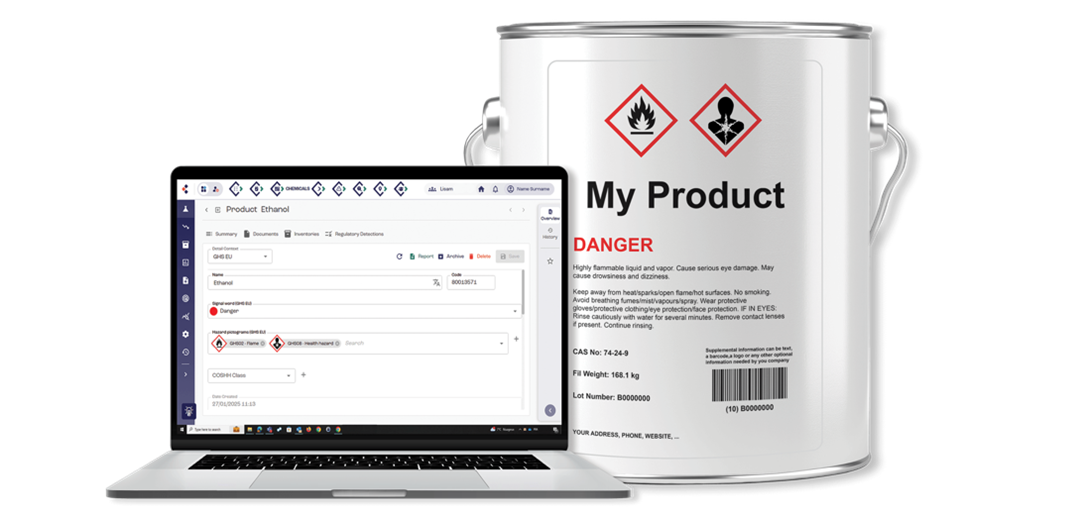Accountability in the Chemical Supply Chain – How Systems Help Companies Ensure Compliance
SPONSORED CONTENT
Let’s be frank: product stewardship can feel overwhelming at times. Regulations evolve, data piles up, and the stakes are high. Here’s the thing, though. Accountability in the chemical supply chain doesn’t have to rest on your shoulders alone.
As a product steward, it’s highly likely your responsibilities don’t stop at your country’s borders. Today you may be focused on a strategy to update product Safety Data Sheets to align with new chemical regulations under the USA OSHA Hazard Communication Standard. Next week, you may be addressing questions on REACH in Europe or WHMIS in Canada. And yet, the expectation is always the same: every shipment, every SDS and every label must be accurate, up-to-date, and harmonized across regions.
Have you ever had to explain a regulatory citation to leadership? Stressful! OSHA HazCom violations may result in penalties up to $16,550 per instance (OSHA, 2024). OSHA’s Hazard Communication Standard (29 CFR 1910.1200) requires employers to maintain accurate SDSs, ensure proper labeling, and provide training so workers understand the risks they face (OSHA, 2024). Beyond fines, inaccurate hazard communication puts employees and chemical users at risk and undermines trust in your company’s hazard communication program.

In other words, accountability isn’t only about regulatory compliance. Accountability serves as the foundation for safe, transparent operations.
If you’ve worked in product stewardship for any length of time, you know that small inconsistencies can create big risks. A mislabeled container. An outdated Safety Data Sheet. A gap in training. While each inconsistency may seem minor on its own, together they add up. And, most times, it’s the frontline worker who feels the impact.
A Common Risk Scenario
Accountability starts at the dock and extends across the entire supply chain. Without reliable systems in place, your company’s risks are sure to multiply. A seemingly small oversight can set off a chain reaction.
Picture this: a shipment of chemicals arrives at your facility. For whatever reason, the receiving clerk doesn’t verify that each SDS and label provided by the suppliers matches the information in your company’s system.
Here’s what might happen:
- Workers unknowingly handle substances without accurate hazard information.
- The workplace becomes an unsafe environment with increased potential for injury or illness.
- Employees may refuse to work. Even worse, legal action may follow.
- Continued violations of Right-to-Know (RTK) laws and OSHA HazCom requirements lead to escalating fines. Willful and repeated violations may incur a penalty of up to $165,514 per instance. (OSHA, 2024)
Accountability in product stewardship is not only about regulations; it’s about people. It means creating an environment where employees trust that the information in front of them is correct, current, and reliable.
Accountability means deploying systems that:
- Ensure every product SDS is properly authored to meet current chemical regulations across countries, languages, and markets.
- Centralize access to SDSs and GHS workplace labels so employees and chemical users work from the same, most current documents.

- Build processes for incident management that verify incoming shipments against the organization’s centralized chemical database and highlight discrepancies before they create confusion.
- Flag the quarantine of non-compliant shipments until corrected SDSs or labels are provided.
- Stay current with regulatory updates, reducing the chance of missing critical changes.
The payoff? For product stewardship professionals, the payoff is not just regulatory; it’s strategic. When accountability is built into systems and company culture, this shared responsibility means:
- Safer workplaces where workers trust the hazard information received.
- Simpler compliance audits with records that are complete and accessible.
- Lower costs from avoiding fines, preventing downtime, and reducing incidents.
And maybe even a better night’s sleep for you. How are you reinforcing safety through accountability in your chemical management program?
Sources:
- OSHA (2024). Hazard Communication Standard (29 CFR 1910.1200). (https://www.osha.gov/laws-regs/regulations/standardnumber/1910/1910.1200)
- OSHA (2024). Enforcement Penalty Policy. (https://www.osha.gov/penalties)
- European Chemicals Agency (ECHA) (2024). REACH and CLP Guidance. (https://www.echa.europa.eu/guidance-documents/guidance-on-clp)
- Government of Canada (2024). Workplace Hazardous Materials Information System (WHMIS 2015). (https://www.ccohs.ca/topics/legislation/WHMIS)

Comments
There are no submissions.